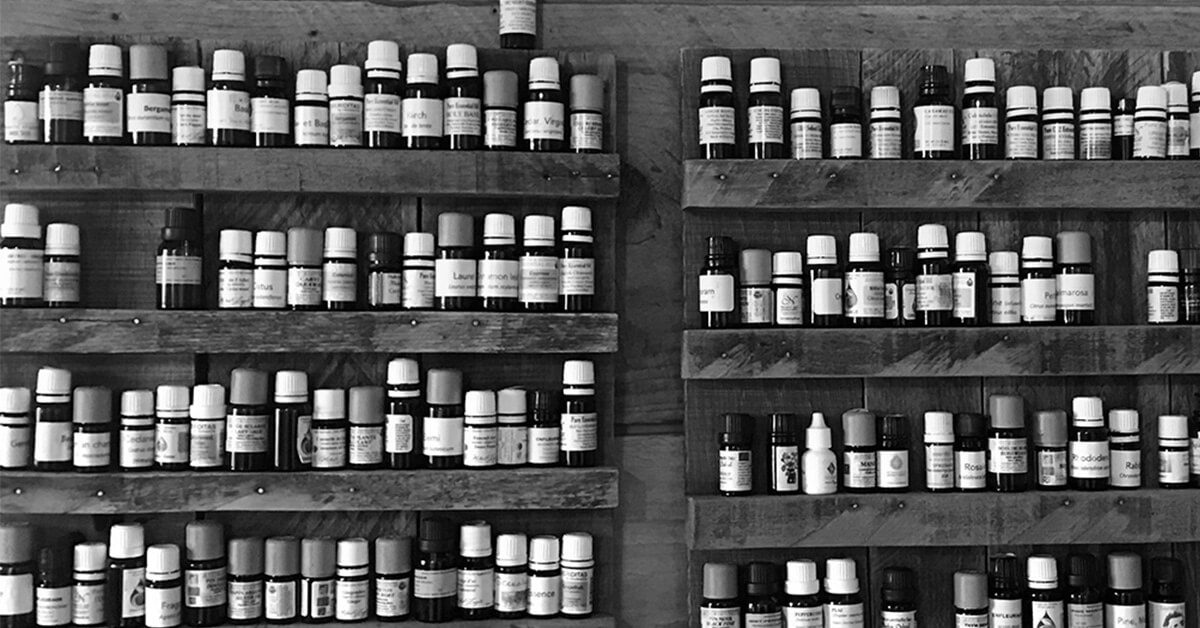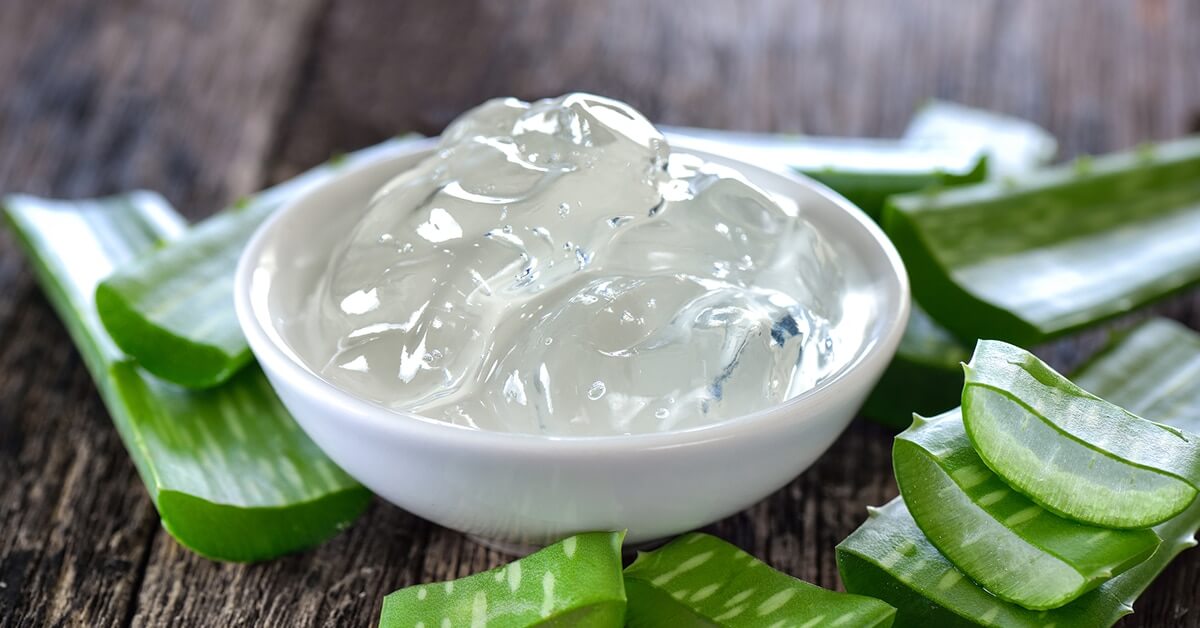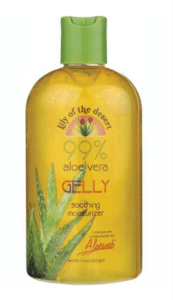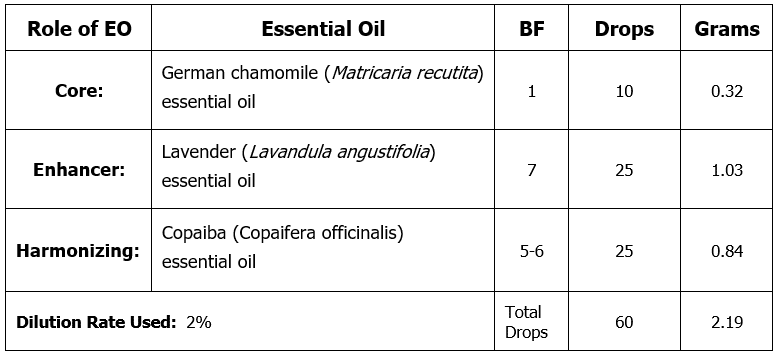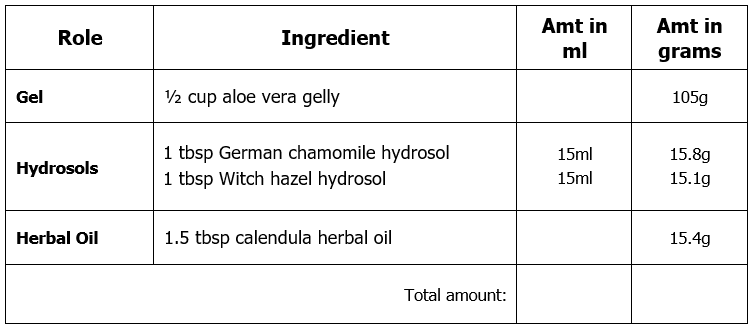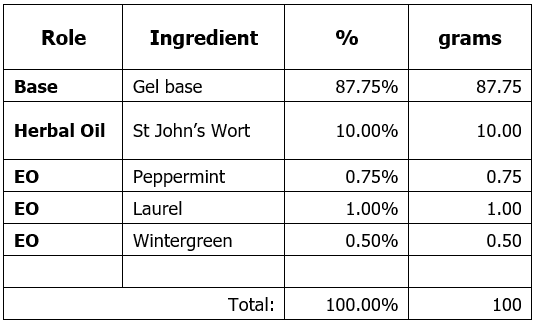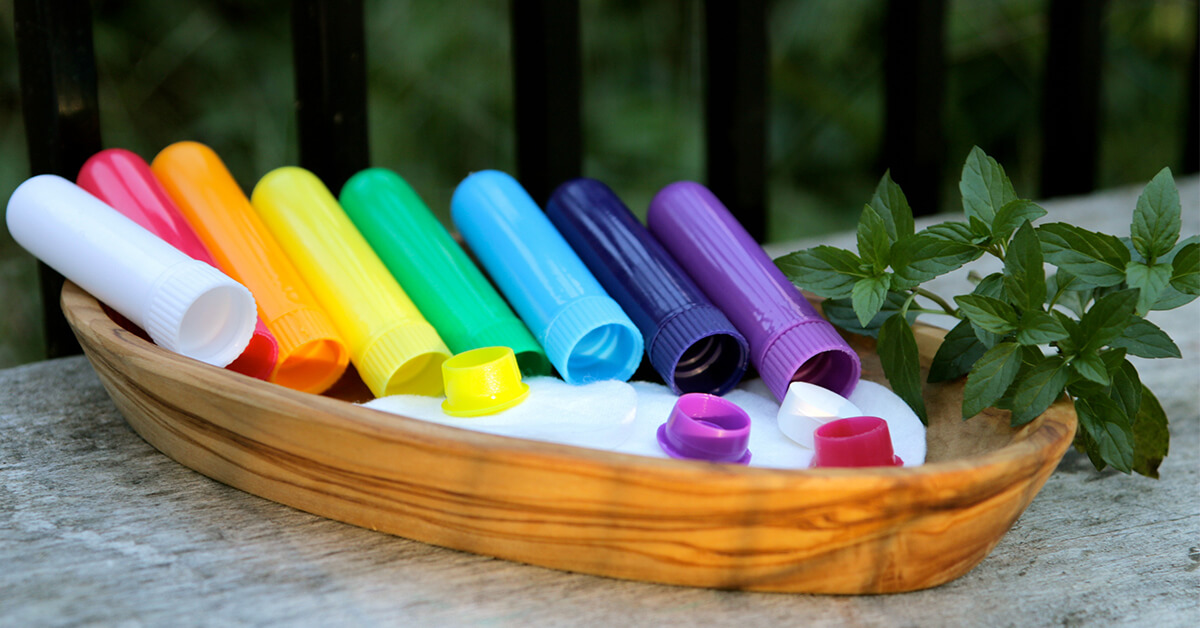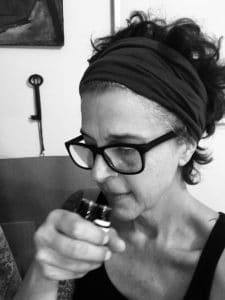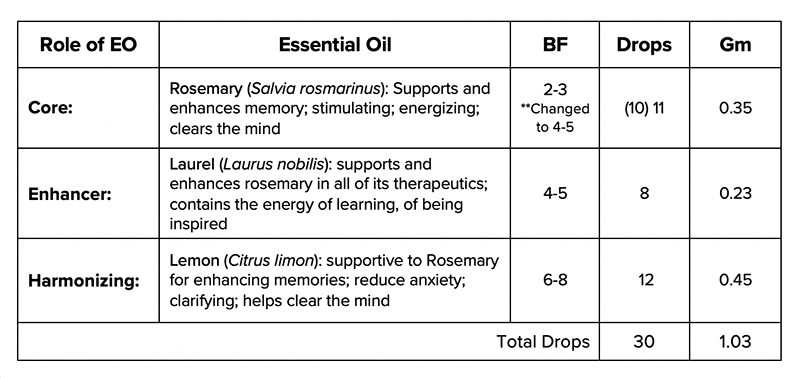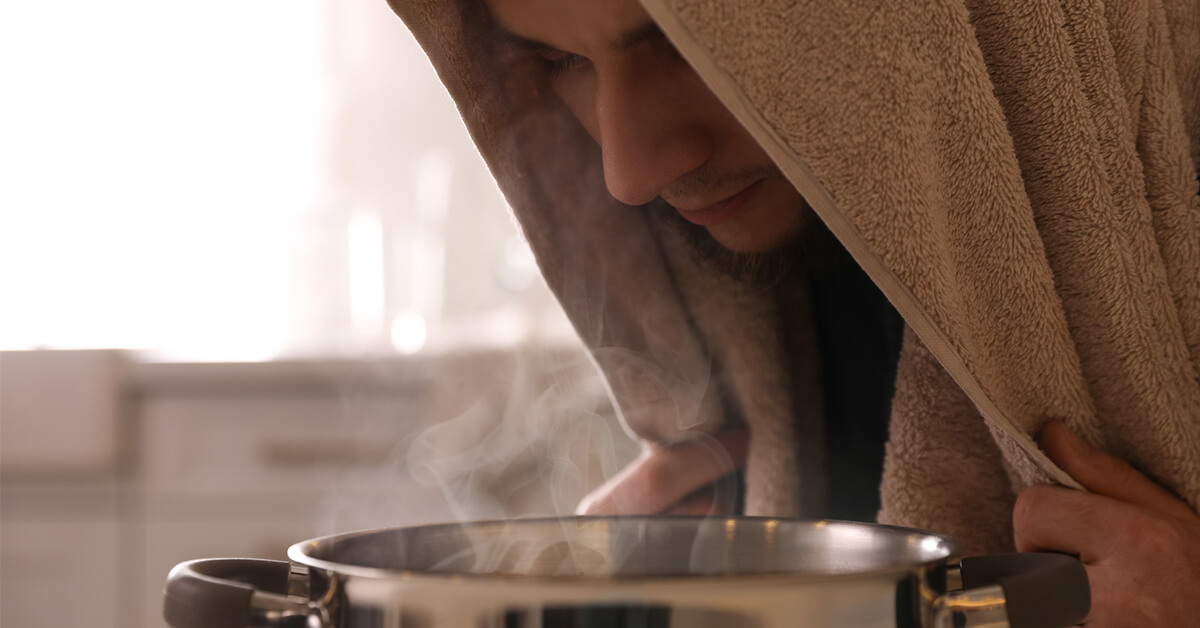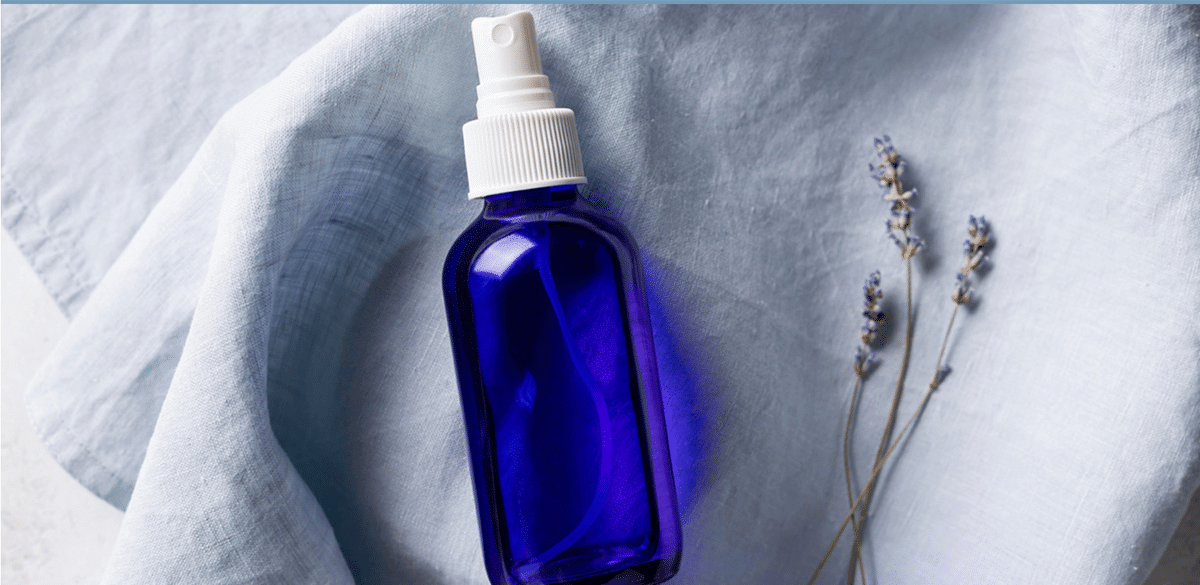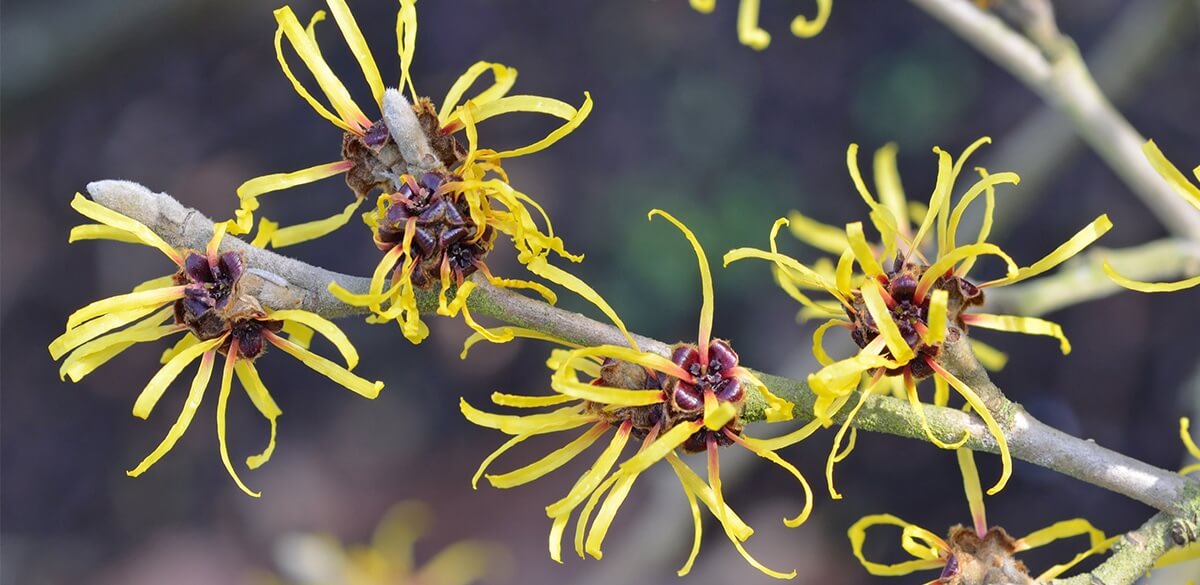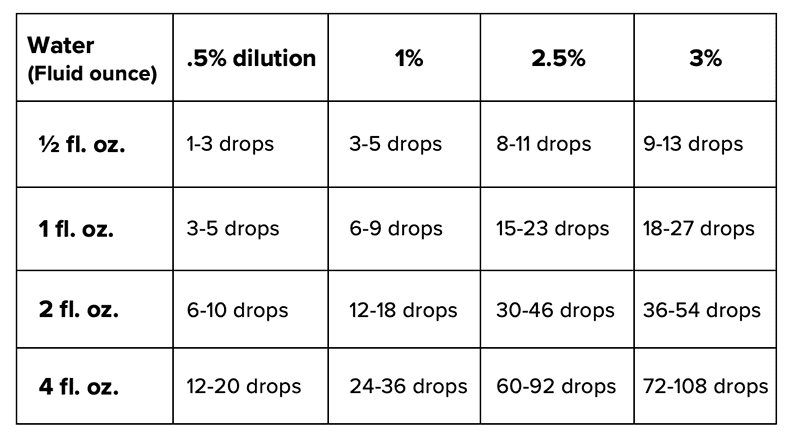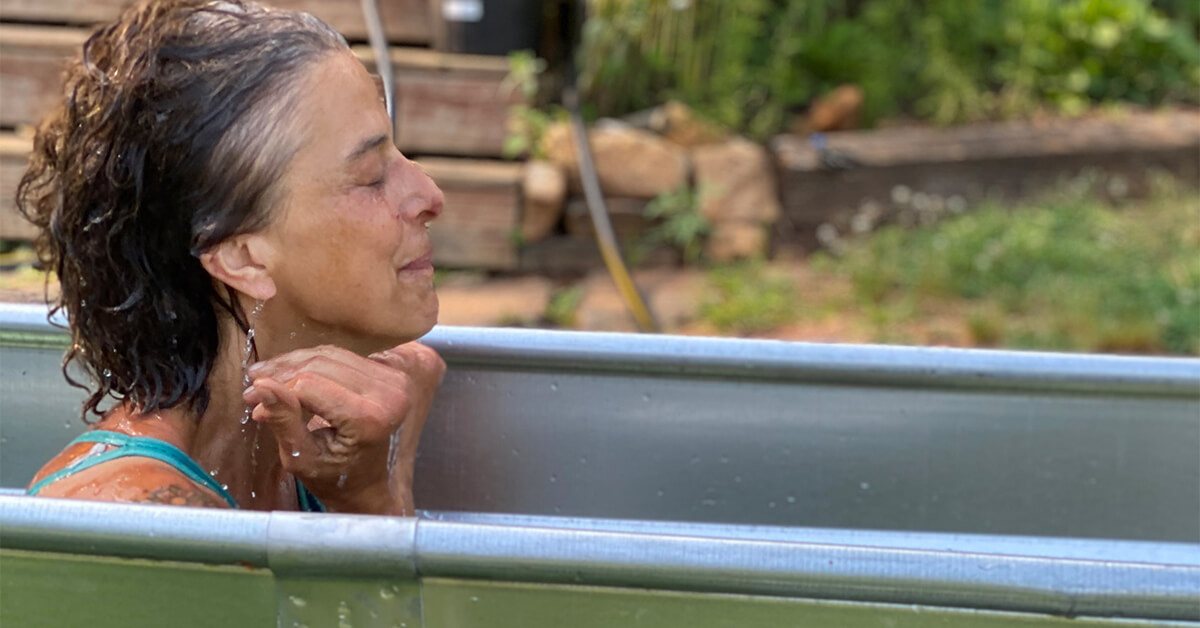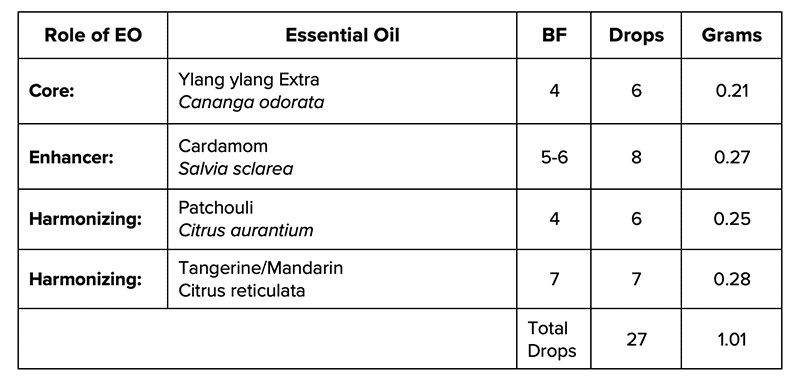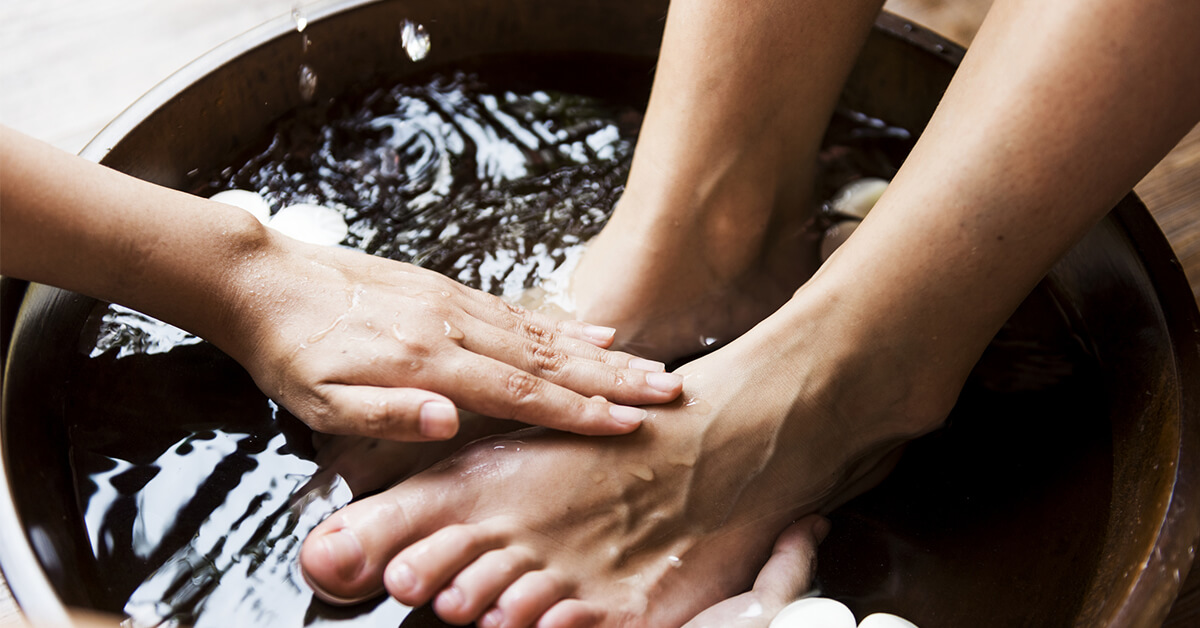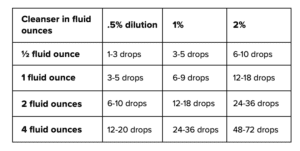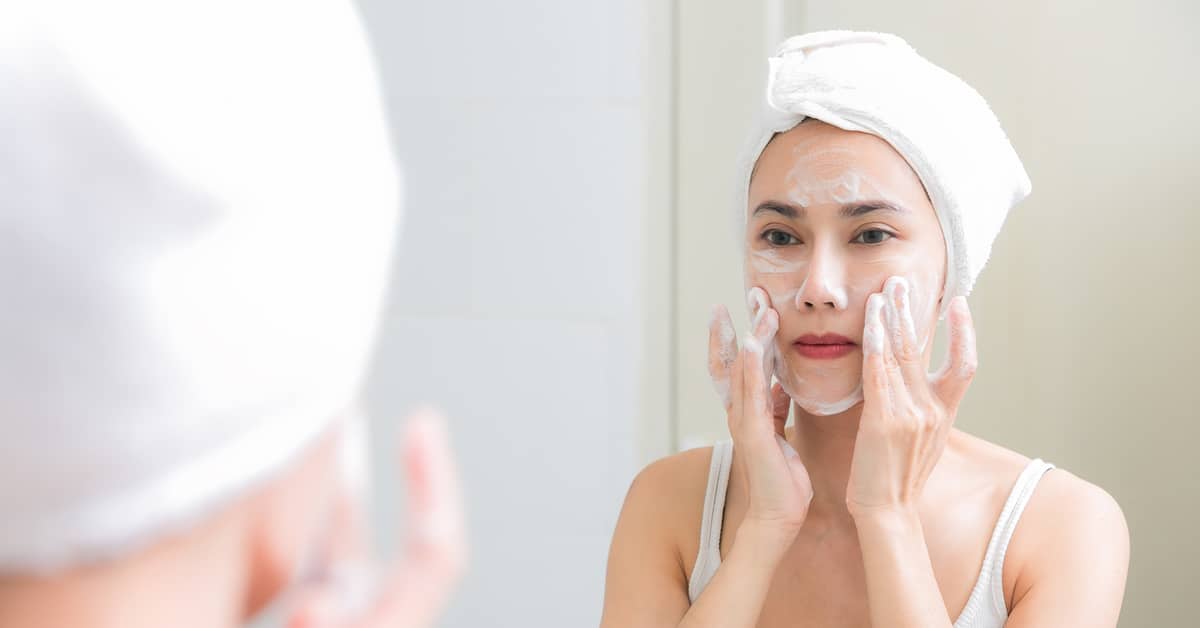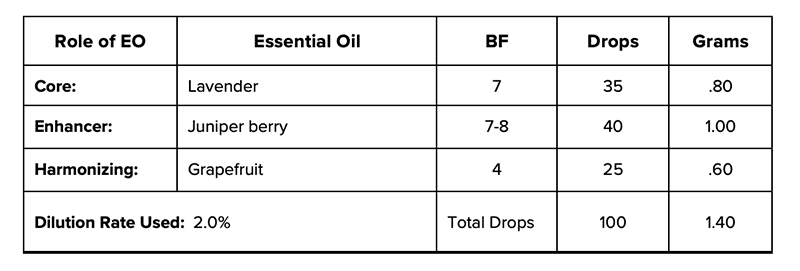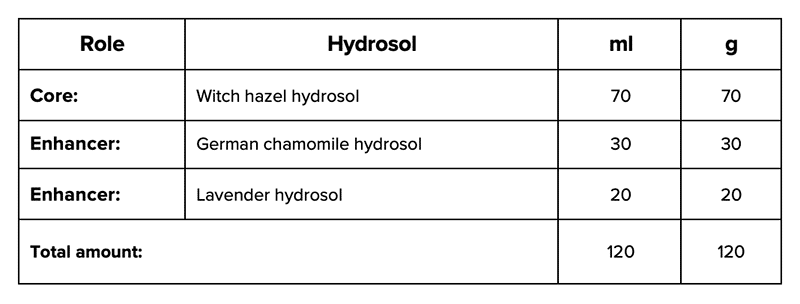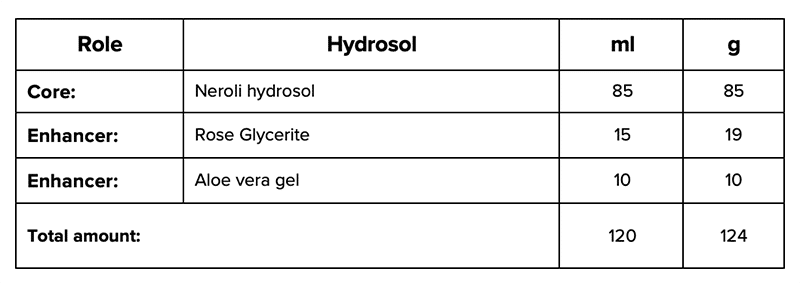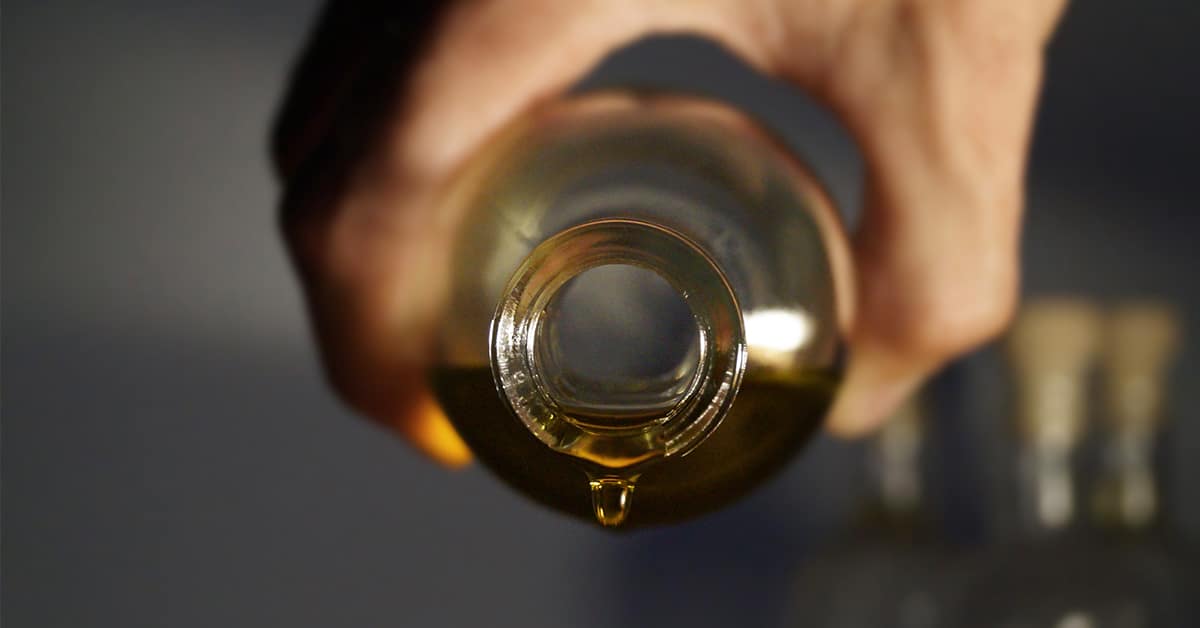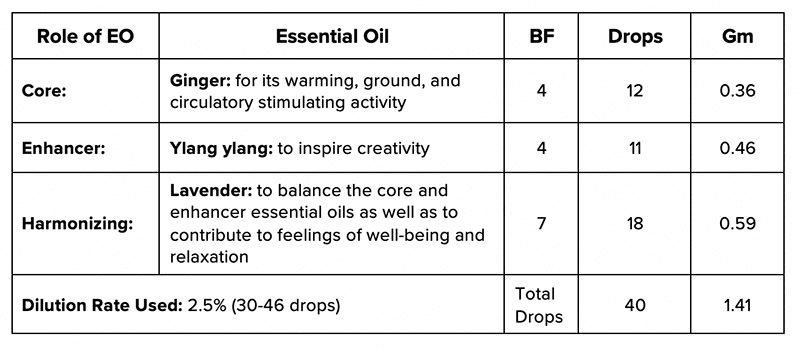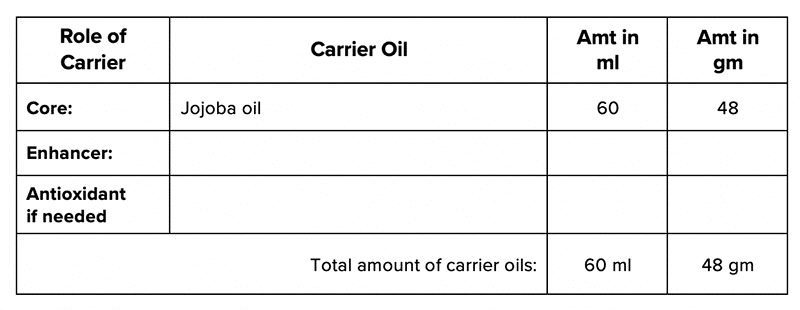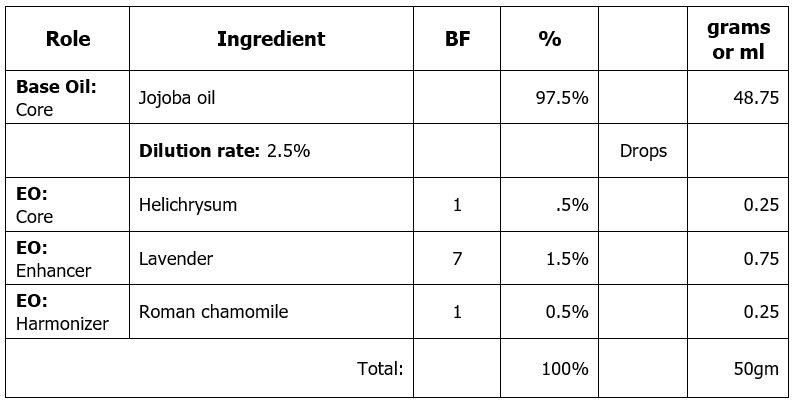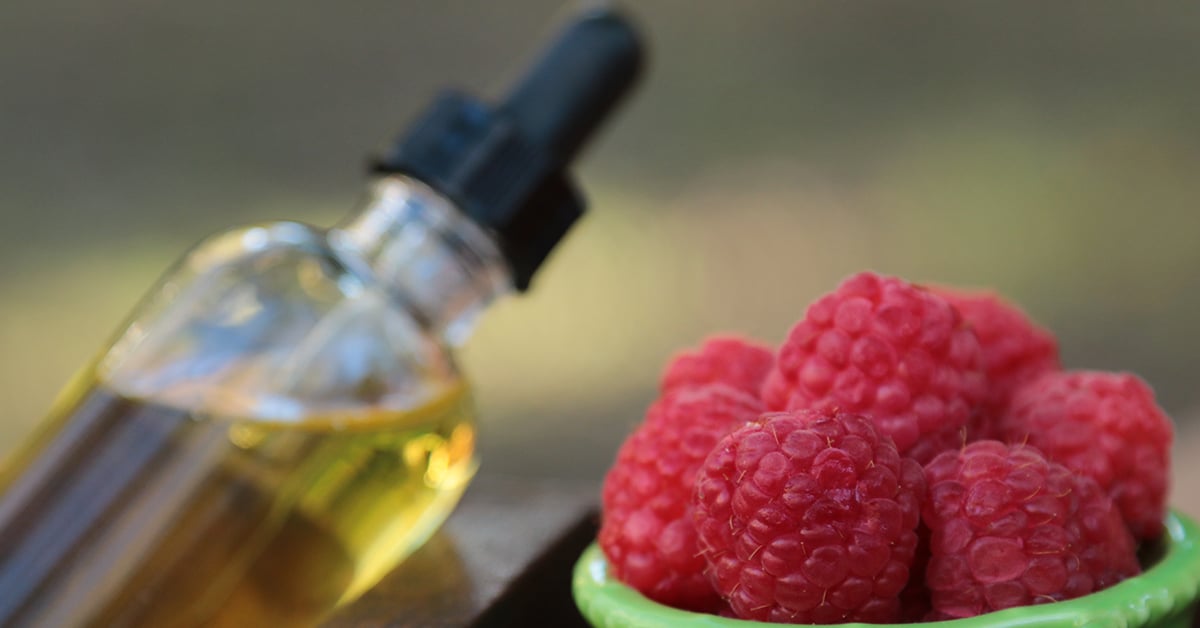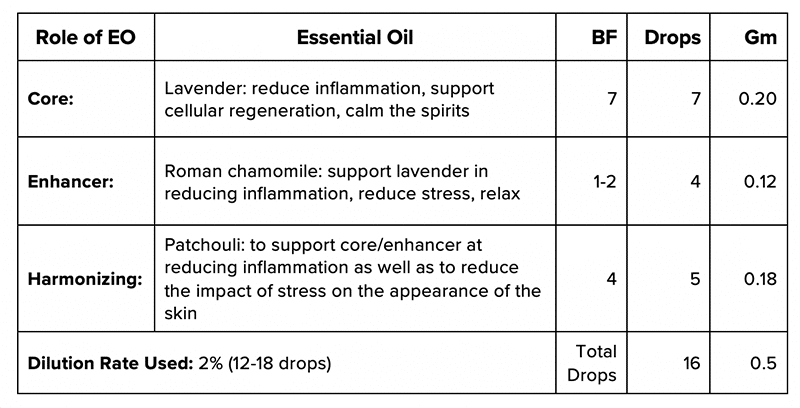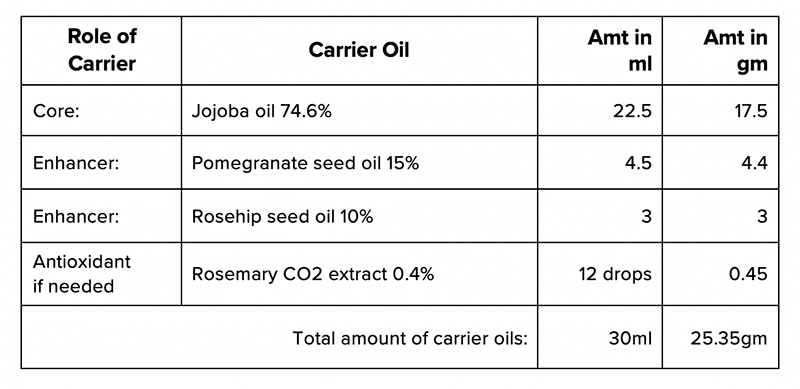Watch Formulating Synergy with Blending Factor with Jade
Step 7: Formulating Your Synergy: How many drops of each essential oil?
The final step in creating the blend is to decide how many drops of each essential oil to use. This can be accomplished by using the blending factor. The Blending Factor is a concept I learned during my education in aromatherapy at the Raworth Centre of Natural Medicine in England. Over the years, many have found that it is an invaluable tool for creating well-balanced blends. The blending factor can be thought of in terms of an aromatic potency scale and is utilized as a tool for determining the appropriate and specific number of drops for each essential oil within a given blend or synergy.
The blending factor is on a scale of 1 to 10.
1 = Powerful aroma, use less in blend
10 = Tends to be more volatile, lighter aroma, use more in blend
Perceiving blending factor
The following exercise is meant to help support your awareness of what determines an individual essential oil’s blending factor.
- Step One: Choose 3 essential oils out of your repertoire of oils.
- Step Two: Remove the lids off all three bottles.
- Step Three: Using both your hands, hold the bottles together so that all the tops are at the same height.
- Step Four: Swirl the bottles under your nose, slowly a number of times. Then pause a moment and repeat. Repeat as needed to gain further insight.
- Step Five: Decide which of the three is the most potent (which one seems to be standing out the strongest), and then place this one down on the table. Then with the remaining two bottles repeat Steps 3, 4 and five.
With only three oils, once you have determined the second most potent essential oil, the remaining oil would be considered the least potent. You then have the oils in a line from most potent to less potent which means the first one will have the least number of drops while the third one shall have the most and the 2nd a middle number of drops.
You will have a chance to work on an exercise to help support your application of blending factor at the end of this section.
Setting a Blending factor
If you find that you are using an essential oil for which no blending factor has been given, then you can use the above exercise to figure it out. Often it is best to compare the unknown essential oil to an essential oil from the same botanical family. For instance, the blending factor for Fir (Abies alba) has not been provided. Fir belongs in the same family as Pine (Pinus sylvestris) and Cedarwood (Cedrus atlantica), both of which have known blending factors.
Blending factor is flexible: The blending factor provides the beginning blender with a way of figuring out how many drops of each essential oil should go into the blend. The blending factor is by no means written in stone for it is meant to be flexible to the essential oils in your repertoire. This means that we acknowledge that essential oils vary in strength from company to company, from year to year, harvest to harvest, etcetera. So one should feel free to adopt different blending factor numbers based upon comparison with other oils of stable potency such as Roman chamomile (Chamaemelum nobile) or Neroli (Citrus aurantium), which would always be on the most potent, a #1 or the citrus oils which are always more volatile and lighter and hence more can be used. (within reason, of course.)
Potency or therapeutic activity: The blending factor is based upon potency of aroma and to a much smaller degree (if at all) therapeutic potency. I would compare blending factors as follows: Roman chamomile has a blending factor of 1 which means it is very ‘potent’ and only a small amount needs to be used for a blend or synergy in relation to other oils being blended. Lavender, on the other hand, has a blending factor of 7 which means a medium or higher percentage of lavender can be used than roman chamomile.
I would also use the concept of blending factor when deciding on how many drops of each essential oil to put in a bath. I would use less of ‘potent’ oils such as Neroli and Roman chamomile (2-3 drops per bath), a medium amount of Geranium (Pelargonium graveolens) or Ylang ylang (Cananga odorata) (3-5 drops per bath) and a higher number of drops for Mandarin (Citrus reticulata) or Lavender (7-10 drops per bath).
Blending factor in practice
Continuing on with our example for Tendinitis/Stress, we can decide on drops as follows:
| Essential oils | Blending factor | Drops |
|---|---|---|
| Lavender | 7 | 12 |
| German chamomile | 1 | 3 |
| Sweet Marjoram | 3 | 6 |
| Helichrysum | 5 | 9 |
| Total 5% dilution = | 30 | |
There are two ways of figuring out the drops: via mathematical equation or by intuitive observation.
I have never been fond of mathematical equations and essential oils do not always fit into precise calculations so the first number chosen is, in a sense, a bit random whilst at the same time maintaining its relation to the others. In this example, German Chamomile and Sweet Marjoram are the two most potent essential oils while Helichrysum is a little more potent than Lavender. Hence, I chose to work with the most potent oils first by designating 3 drops for German Chamomile and 6 drops for Sweet Marjoram. This added up to 9 drops leaving 21 drops to be divided between the other two oils. I then examined the varying strengths of the Helichrysum and Lavender in my repertoire of essential oils and decided on 9 drops for Helichrysum and 12 drops for Lavender.
The mathematical equation method of figuring out exact drops would be performed as follows:
| Essential oils | Blending factor | Drops |
|---|---|---|
| Lavender | 7 | |
| German chamomile | 1 | |
| Sweet Marjoram | 3 | |
| Helichrysum | 5 |
First add up the total blending factors: 7 +1+3+5 = 16
Then divide the blending factor number for each essential oil by 16, which would look something like this.
| Essential oils | Blending factor | Formula |
|---|---|---|
| Lavender | 7 | 7 divided by 16 = .4375 |
| German chamomile | 1 | 1 divided by 16 = .0625 |
| Sweet Marjoram | 3 | 3 divided by 16 = .1875 |
| Helichrysum | 5 | 5 divided by 16 = .3125 |
You now have the percentage for each essential oil which make up the 30 drops for the 5% dilution. To obtain the actual number of drops you would then multiply the percentage for each essential oil by 30.
| Essential Oil | Blending Factor | Equation |
|---|---|---|
| Lavender | 7 | .4375 * 30 = 13 drops |
| German chamomile | 1 | .0625 * 30 = 2 drops |
| Sweet Marjoram | 3 | .1875 * 30 = 6 drops |
| Helichrysum | 5 | .3125 * 30 = 9 drops |
The final blend would then look like this:
Essential oils Blending factor Drops
Lavender 7 13
German chamomile 1 2
Sweet Marjoram 3 6
Helichrysum 5 9
Total 5% dilution = 30
As you can see, the final results using the mathematical formula are pretty close to what I originally got with the more intuitive approach. A blending factor chart has been provided below.
Blending Factor Chart
| Latin Name | Common name | Blending factor |
|---|---|---|
| Salvia sclarea | Clary sage | 2 - 3 |
| Chamaemelum nobile | Roman chamomile | 1 - 2 |
| Cupressus sempervirens | Cypress | 5 |
| Eucalyptus globulus | Eucalyptus | 1 - 5 |
| Foeniculum vulgare var. dulce | Sweet Fennel | 3 - 4 |
| Boswellia carteri | Frankincense | 4 - 5 |
| Pelargonium graveolens | Geranium | 2 - 3 |
| Zingiber officinale | Ginger | 4 |
| Citrus paradisi | Grapefruit | 7 - 8 |
| Helichrysum italicum | Helichrysum | 3 - 5 |
| Juniperus communis | Juniper berry | 4 |
| Laurus nobilis | Bay Laurel | 4 - 5 |
| Lavandula officinalis | Lavender | 7 |
| Citrus limon | Lemon | 6 - 8 |
| Cymbopogon citratus | Lemongrass | 1 |
| Citrus reticulata | Mandarin | 7 |
| Citrus sinensis | Sweet Orange | 7 - 8 |
| Pogostemom patchouli | Patchouli | 4 |
| Mentha x piperita | Peppermint | 1 - 2 |
| Pinus sylvetris | Pine, Scots | 6 |
| Rosmarinus officinalis | Rosemary | 3 - 5 |
| Melaleuca alternifolia | Tea tree | 3 |
| Vetiveria zizanioides | Vetiver | 1 |
| Cananga odorata | Ylang ylang | 4 |
